Definition:
Respiration is the process by which living organisms inhale oxygen from their surroundings and release carbon dioxide as a waste product. Respiration, in the context of human biology, refers to the exchange of gases between the lungs and the blood. In mammals, this process normally involves the intake of oxygen and the release of carbon dioxide. It is crucial for the existence of all living species because it provides the energy required for cellular metabolism.
Classification:
Based on the type of organism
Aerobic respiration
It can be found in the majority of living organisms, including people, animals, plants, and many microbes. It occurs in the presence of oxygen and is the most efficient way for cells to produce energy.
Anaerobic respiration
It occurs in some microorganisms, such as bacteria and yeast. It occurs in the absence of oxygen and is less efficient than aerobic respiration.
Based on the location of respiration
External respiration: External respiration is the process by which an organism’s respiratory system exchanges gases with the environment. It takes place predominantly in the lungs of animals, where oxygen is taken up from the air and transferred to the bloodstream, while carbon dioxide is released from the bloodstream and expelled from the body. This gas exchange occurs in a sequence of processes that include air inhalation into the lungs, oxygen diffusion over the thin walls of the alveoli, and carbon dioxide release during expiration. External respiration is critical for maintaining proper levels of oxygen and carbon dioxide in the body, which is necessary for cell activity and overall health.
Internal respiration: Internal respiration is the process of cellular respiration that takes place within a cell of organism. The cells use oxygen to break down glucose and other organic molecules, producing energy in the form of ATP (adenosine triphosphate) and releasing carbon dioxide as a waste product. This process occurs within the mitochondria of the cell and is critical for the survival of all aerobic creatures, including humans.
Based on the type of metabolism
Catabolic respiration
It includes the breakdown of complex substances like glucose to release energy.
Anabolic respiration
It includes the use of energy for synthesizing complex molecules from simpler forms.
Based on the organ system involved
Pulmonary respiration
The exchange of oxygen and carbon dioxide between the atmosphere and the body’s tissues is referred to as pulmonary respiration. This process takes place in the lungs, where red blood cells in capillaries absorb oxygen from the air, and where blood releases carbon dioxide into the air in the lung.
Cellular respiration
Cellular respiration is the mechanism through which cells metabolize nutrients into ATP, the fundamental energy source for cellular functions. It proceeds through a sequence of processes that can happen in both aerobic and anaerobic circumstances and is necessary for the survival and function of cells and organisms.
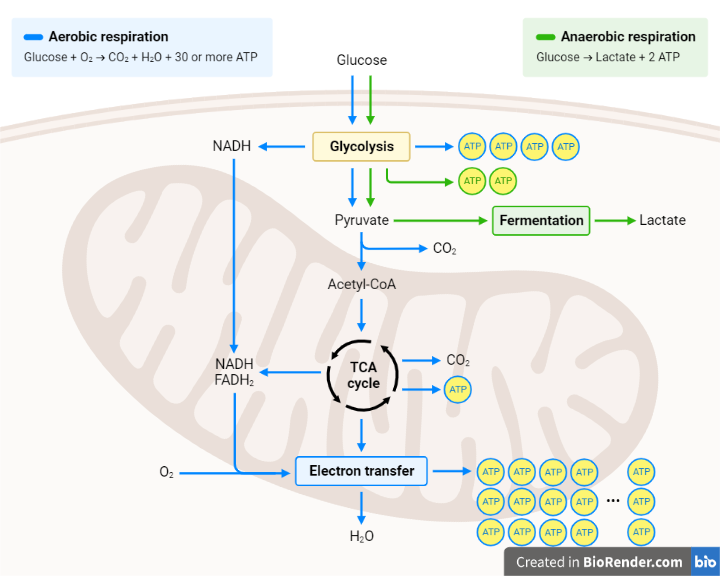
Fig: Cellular respiration
Aerobic Respiration:
The different stages of Aerobic Respiration are as follows:
Glycolysis
This occurs in the cytoplasm of cell and is the first stage of aerobic respiration. Two molecules of pyruvate are produced from the breakdown of glucose during glycolysis. Nicotinamide adenine dinucleotide (NADH), a coenzyme that transports electrons to the following stage of respiration, and a little quantity of ATP are also produced during this process.
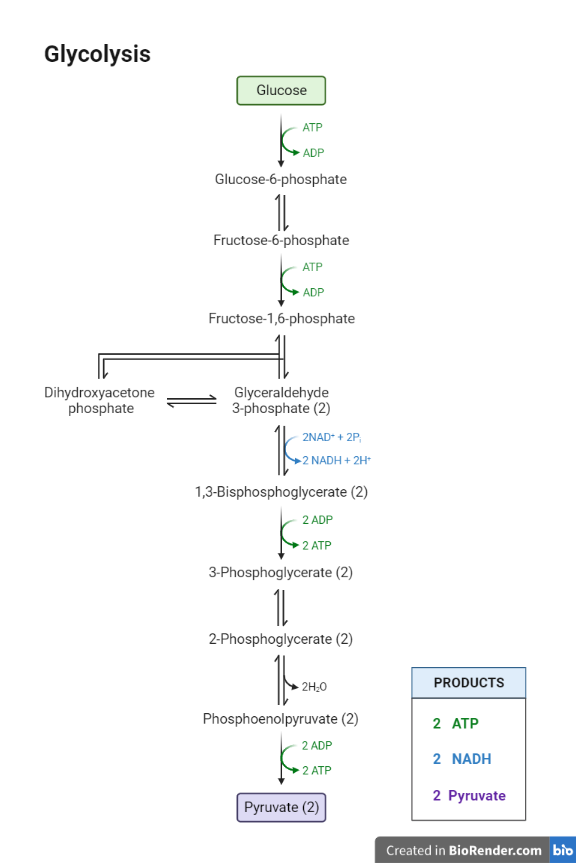
Fig:Cellular respiration
Citric Acid Cycle (Krebs cycle)
This process, which takes place in the mitochondria, involves the oxidation of pyruvate to produce molecules with high energy content, including ATP, NADH, and FADH2 (flavin adenine dinucleotide). During this phase, the acetyl-CoA produced from pyruvate enters the Krebs cycle where it is broken down into carbon dioxide and water. The energy released during this process is used to produce ATP and electron carriers such as NADH and FADH2.
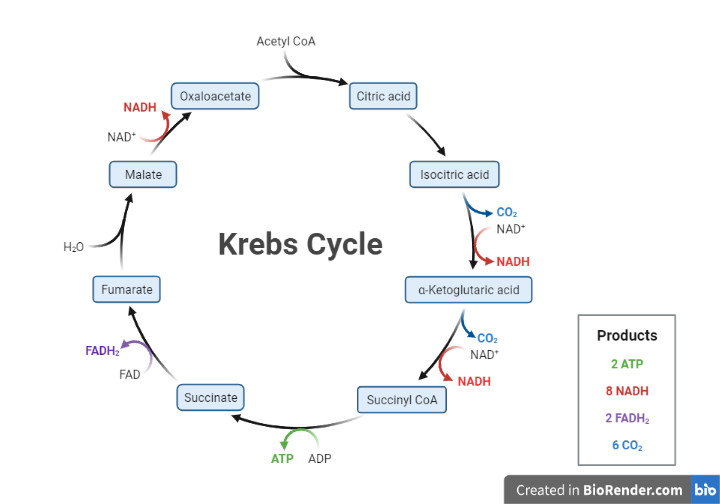
Fig: Citric Acid Cycle (Krebs cycle)
Electron Transport Chain (ETC)
This is the final phase of aerobic respiration, which takes place in the mitochondria’s inner membrane. The electron carriers generated during the earlier stages provide their electrons to the ETC during this stage, establishing a proton gradient across the inner membrane. This gradient is subsequently used to generate ATP via a process known as oxidative phosphorylation.

Fig: Electron Transport Chain (ETC)
Anaerobic respiration:
There are two main types of anaerobic respiration:
Alcoholic fermentation
Alcoholic fermentation, commonly known as ethanol fermentation, is a biological process that converts sugar into alcohol and carbon dioxide which is common in yeast and some bacteria. It is a metabolic process which is widely used in producing alcoholic beverages such as beer and wine where enzymes or microorganisms induce the decomposition of glucose into ethanol (alcohol) and carbon dioxide.
The process starts with glycolysis, which converts glucose to pyruvate in the same way as aerobic respiration. However, instead of entering the Krebs cycle and electron transport chain, pyruvate is transformed into acetaldehyde, which is subsequently converted into ethanol. This procedure produces a small amount of ATP.
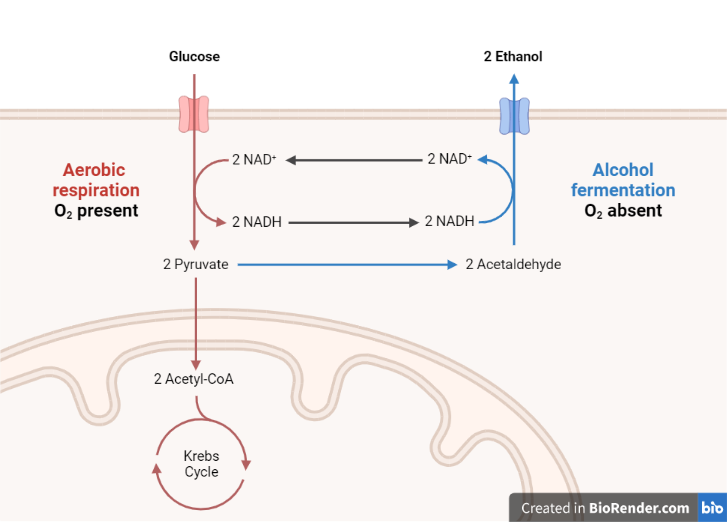
Fig: Alcoholic fermentation
Lactic acid fermentation
It is a metabolic process commonly referred to as lacto-fermentation It occurs in Lactic acid bacteria such as Lactobacillus spp., lactococci, Streptococcus thermophilus, and leuconostocs that have the ability to convert sugars into lactic acid. Moreover, it is also occurred in animal cells, including muscle cells, when oxygen is not available for aerobic respiration in order to produce energy during anaerobic conditions.
The process begins with glycolysis, which breaks down glucose into two pyruvate molecules, producing a little quantity of ATP. In the absence of oxygen, the enzyme lactate dehydrogenase converts pyruvate to lactate, which then generates NAD+ from NADH.
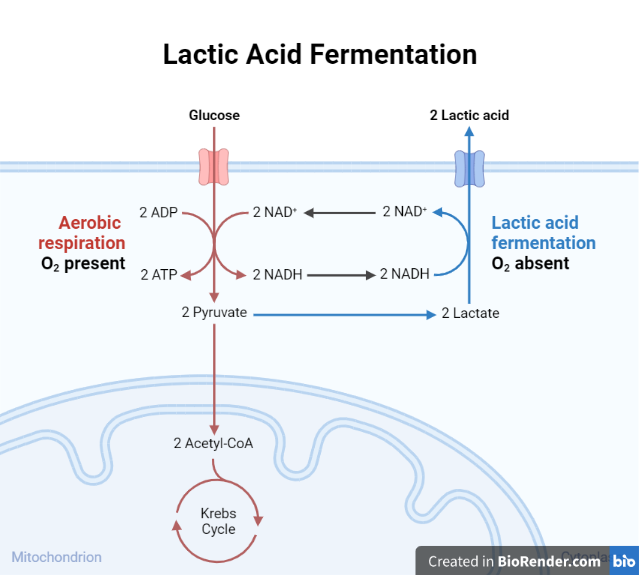
Fig: Lactic acid fermentation
Human Respiratory System:
The respiratory system is functionally divided into two zones: conducting zones (nose to bronchioles) that establish a path for the conduction of inhaled gases and respiratory zones (alveolar duct to alveoli) where gas exchange occurs. The respiratory system is anatomically separated into upper (organs outside the thorax – nose, pharynx, and larynx) and lower (organs within the thorax – trachea, bronchi, bronchioles, alveolar duct, and alveoli).
Upper respiratory tract
The upper respiratory tract refers to the portion of the respiratory system that includes the organs located above the trachea, which is the tube that connects the larynx to the lungs. These organs filter, warm, and moisten the air we breathe, as well as protect the lower respiratory tract from foreign particles and pathogenic pathogens. Infections or inflammation of the upper respiratory tract can lead to illnesses such as the common cold, flu, sinusitis, and laryngitis.
The upper respiratory tract consists of several organs.
Nose: The nose is the principal organ of the respiratory system, filtering, warming, and moistening the air we breathe. It is also responsible for detecting fragrances.
Nasal Cavity: The nasal cavity is a wide air-filled region behind the nose that connects to the back of the throat. It is lined with microscopic hair-like structures called cilia, which help to capture and remove foreign particles from the air.
Pharynx: The pharynx is a muscular tube that connects the nasal cavity and mouth to the larynx and esophagus which functions as a passageway for both air and food.
Larynx: The larynx, often known as the voice box, is situated at the top of the trachea. It is in responsible for generating sound as well as protecting the trachea while swallowing.

Fig: Human respiratory system
Lower respiratory tract
The lower respiratory tract is the part of the respiratory system that contains the organs located below the trachea, which is the tube that connects the larynx to the lungs. These organs cooperate to make sure that the body receives a consistent supply of oxygen and is able to eliminate carbon dioxide waste. When the lower respiratory tract becomes infected or inflamed, it can lead to illnesses such as pneumonia, bronchitis, asthma, and chronic obstructive pulmonary disease (COPD).
The lower respiratory tract consists of several organs, including:
Trachea: Also known as the windpipe, the trachea is a tube that connects the larynx to the bronchi. It is lined with cilia, which are small hair-like structures that assist capture and remove foreign particles from the air.
Bronchi: The bronchi are two branches of the trachea that lead to the lungs. They split into smaller tubes known as bronchioles.
Lungs: The lungs are two spongy organs placed in the chest that exchange gases between the air we breathe and the blood. They are separated into lobes and protected by a sac called the pleura.
Alveoli: Alveoli are small air sacs found at the ends of the bronchioles of the lungs. They are in responsible for the exchange of oxygen and carbon dioxide between the blood and the environment.
Pleura: The pleura is a thin, double-layered membrane that lines the inside of the chest cavity and covers the lungs. It protects the lungs and allows them to move freely during breathing.
References:
- Patwa A, Shah A. Anatomy and physiology of respiratory system relevant to anaesthesia. Indian J Anaesth. 2015 Sep;59(9):533-41.
- Comroe, J.H., 1965. Physiology of respiration. Academic Medicine, 40(9), p.887.
- Nelson, D.L., Lehninger, A.L. and Cox, M.M., 2008. Lehninger principles of biochemistry. Macmillan.
- Ionescu, C.M., 2013. The human respiratory system: an analysis of the interplay between anatomy, structure, breathing and fractal dynamics. Springer Science & Business Media.
- Wiebe, W.J., Christian, R.R., Hansen, J.A., King, G., Sherr, B. and Skyring, G., 1981. Anaerobic respiration and fermentation. The ecology of a salt marsh, pp.137-159.
- Pedersen, M.B., Gaudu, P., Lechardeur, D., Petit, M.A. and Gruss, A., 2012. Aerobic respiration metabolism in lactic acid bacteria and uses in biotechnology. Annual Review of Food Science and Technology, 3, pp.37-58.
